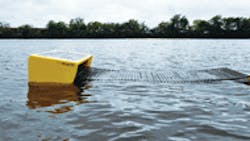Maybe oil spills will always be a risk in a world so dependent on petroleum, but researchers at MIT have moved one step closer to developing a technology that can better clean up spills when they happen.
MITs Senseable City Lab has created a fleet of robots that can cruise the ocean and clean up surface oil slicks. The system, called Seaswarm, is a group of robots that use a conveyor belt covered with a thin nanowire mesh to absorb oil. The fabric can absorb up to 20 times its own weight in oil while repelling water. By heating up the material, the oil can be removed and burnt locally and the nanofabric can be reused.
The first prototype was successfully tested in Bostons Charles River in August, and it responded well to the waters changing surface.
Oil-skimming technology used today, called skimmers, are attached to large vessels and need to constantly return to shore for maintenance and repair. Since early this summer, over 800 skimmers have been deployed in the Gulf of Mexico to help clean the BP spill. But early estimates have found that only 3% of the surface oil has been collected by these skimmers.
Unlike traditional skimmers, Seaswarm is based on a system of small, autonomous units that behave like a swarm and digest the oil locally while working around the clock without human intervention, says Senseable City Lab Director Carlo Ratti.
The robot units will use wireless communication and GPS technology to coordinate their cleanup and ensure an even distribution over a spill site. By detecting the edge of a spill and moving inward, a single vehicle could clean an entire site autonomously or engage other vehicles for faster cleaning.
We hope that giant oil spills such as the Deepwater Horizon incident will not occur in the future. However, small oil leaks happen constantly in offshore drilling, Ratti said. The brief we gave ourselves was to design a simple, inexpensive cleaning system to address this problem.
MIT researchers estimate that a fleet of 5,000 Seaswarm robots would be able to clean a spill the size of the one in the Gulf of Mexico in one month. The team has future plans to enter their design into the X-Prizes $1 million oil-cleanup competition, which will award the group that can most efficiently collect surface oil with the highest recovery rate.
